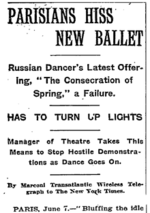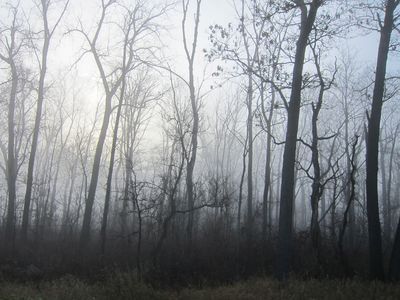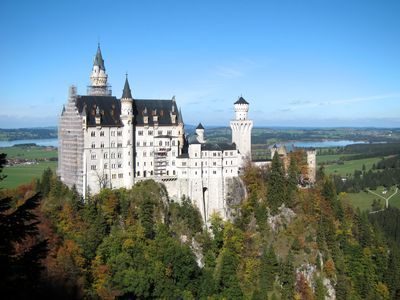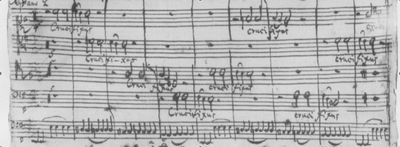Alex Ross's Blog, page 180
November 20, 2012
Simile of the year
Residents of a West 57th Street building threatened by a hurricane-damaged crane describe the noise of the crane snapping apart: "'If you know the opera Salome,' said Naomi Graffman, who has lived in the Osborne since 1962, 'the way the double basses play as they’re starting to cut off John the Baptist’s head — it sounded like that.'" For good measure, there are also references to The Shining. (Via Raphael Mostel.)
Rite postscript
 In a recent column on the Rite of Spring conference at the University of North Carolina, I noted some remarks that the musicologist Richard Taruskin made on the subject of his work Stravinsky and the Russian Traditions. This 1757-page masterpiece of scholarship, which I discussed in the New York Times in 1996, dominates the Stravinsky bibliography, yet it is not invulnerable to shifting intellectual tides, as Taruskin acknowledges. In a question-and-answer session, he said that a couple of his statements — notably, the declaration that "Stravinsky was the most completely Russian composer of art music that ever was and, if present trends continue, that ever will be" — could now be seen as overzealous. At the time, Taruskin pointed out, he was "writing against the force of this entrenched discourse" — the formalist reading of Stravinsky that the composer himself encouraged, with all manner of misinformation concealing his early Russian influences.
In a recent column on the Rite of Spring conference at the University of North Carolina, I noted some remarks that the musicologist Richard Taruskin made on the subject of his work Stravinsky and the Russian Traditions. This 1757-page masterpiece of scholarship, which I discussed in the New York Times in 1996, dominates the Stravinsky bibliography, yet it is not invulnerable to shifting intellectual tides, as Taruskin acknowledges. In a question-and-answer session, he said that a couple of his statements — notably, the declaration that "Stravinsky was the most completely Russian composer of art music that ever was and, if present trends continue, that ever will be" — could now be seen as overzealous. At the time, Taruskin pointed out, he was "writing against the force of this entrenched discourse" — the formalist reading of Stravinsky that the composer himself encouraged, with all manner of misinformation concealing his early Russian influences.
In my column, I mentioned a paper by Annegret Fauser, in which it was suggested that the French influence on the Rite was more pronounced than the reader of Stravinsky and the Russian Traditions might assume. I should also have mentioned a subsequent paper by Brigid Cohen, since the statements quoted above were made immediately after she spoke. Cohen, drawing on the work of Raymond Williams, has made a study of migratory patterns in twentieth-century music history, particularly with reference to the extraordinary career of Stefan Wolpe; she feels that too much emphasis has fallen on "nation-centered histories." In the case of the Rite of Spring, she called for a less nationally rooted understanding of the score, for a richer awareness of its cosmopolitan context. This is an illuminating perspective on the Rite, complementing Fauser's account of the score's Frenchness, and I regret not having included it in my report.
Celebrations of the Rite centennial are just beginning. The Théâtre des Champs-Elysées, site of the première, is presenting no fewer than six versions of the score this season, three staged and three in concert. On the anniversary itself, the Mariinsky Ballet, with Valery Gergiev conducting, will dance the original Nijinsky choreogoraphy in the reconstruction by Millicent Hodson and Kenneth Archer; a new vision by Sasha Waltz will appear on the same program. Taruskin is to speak again at an accompanying conference.
November 18, 2012
Wisconsin in November
Many thanks to all those who came out to hear me at UW Milwaukee on Thursday and Friday. My hosts at the Peck School of the Arts were most kind. I was delighted to meet Tom Strini, writer and editor at the online arts hub Third Coast Digest. In my talk, I sounded a somewhat pessimistic tone about the fate of arts criticism, given the hostile attitude of so many newspapers and periodicals around the country, but Third Coast Digest, like ArtsATL in Atlanta and the Arts Desk in the UK, is suggesting an alternative future. Unfortunately, I couldn't stay around to hear Timothy Andres's new work Comfort Food, which Present Music plays this afternoon.
November 14, 2012
Cage unending
As I note at the beginning of my column this week, in May 1913 the Paris magazine Montjoie made a point of disdaining the centennial celebrations of Richard Wagner that were then preoccupying cultural publications around the world. Instead, it declared that the best way to honor Wagner would be to embrace a new work by a radical young composer — as it turned out, Stravinsky's Rite of Spring. Now, rather ironically, the Rite has become one more cog in the anniversary machine that drives so much classical programming. There is much to be said against the anniversary racket, and Bob Shingleton said it well in a recent post. You can't find a more painfully obvious symbol of classical music's excessive fixation on the past. Nonetheless, I feel differently about the current cluster of events around twentieth-century composers and works: Cage, Britten, Nancarrow, the Rite, Pierrot lunaire. This is not a repetition of the already familiar; mainstream audiences are still coming to terms with the twentieth-century legacy, and these anniversaries are a chance to carry that process forward, and, perhaps, to banish at long last the "modern music" bogeyman.
All this is a roundabout prelude to further news about the Cage centennial, which continues to yield fascinating programs around the world. On Saturday, Bard College, home of the John Cage Trust, hosts On & Off the Air!, a celebration of Cage's radio work. A John Cage Festival at Northwestern University's Bienen School of Music starts tomorrow and runs through the weekend, with performances by the likes of So Percussion and Stephen Drury. Two full days of talks and discussions include a presentation by D. J. Hoek on Northwestern's Cage collection. Down in Philadelphia, the ongoing Beyond Silence festival will turn its focus after Thanksgiving to the Song Books, with Joan La Barbara performing. Dancing Around the Bride, a panoramic exhibition of Cage, Cunningham, Johns, Rauschenberg, and Duchamp, is on display at the Philadelphia Museum of Art. On Nov. 24, the Orchestre Philharmonique Luxembourg begins a series called Good Luck Rainy Days. And, here in New York, a Symphony Space series focused on Cage's 1989 improvisation exercise How to Get Started is pairing writers and musicians; tomorrow it's Wallace Shawn and Allen Shawn (sons of the legendary New Yorker editor William Shawn), and on Dec. 13 it's Robert Pinsky and John Wesley Harding, aka Wesley Stace. More events can be found at Cage 2012.
November 13, 2012
Appearances in Milwaukee
Appearance in Milwaukee
November 12, 2012
Rite, Joyce
November 10, 2012
Wunderreich
On my last German trip, I made a detour to Neuschwanstein, which I'd never visited. Yes, it's a tourist trap, but it's also a staggering vision — the most extreme, although by no means the most faithful, expression of Wagnerian fervor. As you can see from the scaffolding on the left-hand side, the castle is undergoing renovation. When I walked by, the construction workers were listening to "Call Me Maybe." So it goes....
Donaueschingen extras
In this week's New Yorker I write about the 2012 edition of the Donaueschingen Music Days. On the SWR website, you can watch videos of two events: the closing concert, with works by Bernhard Gander, Aureliano Cattaneo, and Franck Bedrossian; and the Nadar Ensemble concert, which includes Stefan Prins's remarkable PlayStation piece Generation Kill. Prins is currently studying for a doctorate at Harvard; I wonder if any American presenter will be brave enough to take on this work, which implies a critique of the American drone program. Those with hardy ears should check out Fremdkörper, Prins's two-disc set on the Sub Rosa label. YouTube has evidence of Johannes Kreidler's now famous instrument-smashing action at the opening concert, protesting the planned merger of the two SWR orchestras. Kreidler, a composer with a bent for high-tech whimsy, is plentifully documented on video; above is Charts Music, which extracts ditsy melodies from plunging stock prices. There's also the mildly demented video world of Trond Reinholdtsen, whose work Musik was an absurdist highlight of Donaueschingen 2012. As for Gander, I'd cautiously recommend videos of his Viennese Radio Symphony project melting pot, which can only be described as Austrian atonal hip-hop.
I should mention that for some years now the Neos label — source of all those invaluable Mieczysław Weinberg recordings, notably the Blu-ray of The Passenger — has been issuing Donaueschingen compilations. I picked up the three-disc 2011 set, which includes Hans Thomalla's mesmerizing California desert fantasia, The Brightest Form of Absence. I've written before about Raphaël Cendo's black-metal apocalypse cantata Introduction aux ténèbres, from the 2009 festival. One of the most treasured items in my record library is the col legno set 40 Jahre Donaueschinger Musiktage; alas, this seems to be out of print. Just out on col lengo is a one-disc portrait of the Austrian composer Clemens Gadenstätter, whose Sad Songs was a Donaueschingen highlight that I lacked space to address; its very ingenious setup included four gongs distributed around the audience, each one vibrating in sympathy with frequencies picked up remotely from the stage.
The real scandal at Donaueschingen, as I pointed out in a previous post, was the paucity of female composers. Only one — Malin Bång — appeared on the main concert series. See The Rambler and Lauren Redhead for a related discussion.
November 8, 2012
Bach, mourner-in-chief
This Saturday, the musical forces of Trinity Wall Street will give a benefit performance of Bach's Mass in B Minor. According to the press release, "The event will benefit the Mayor’s Fund to Advance New York City, which is gathering donations to provide essential living supplies to New Yorkers in need – including food, water, blankets, baby supplies, and other emergency items. The Mayor’s Fund retains no administrative fee, and 100 percent of donations are being dispersed to relief efforts and organizations to provide essential living supplies to storm victims in the New York City area." Julian Wachner will conduct. I think back to the Bach Collegium Japan's rendition of the Mass at Carnegie last year, in the wake of the terrible Tohoku earthquake. It will probably once again seem as if Bach had heard the bad news in advance.
Alex Ross's Blog
- Alex Ross's profile
- 425 followers






